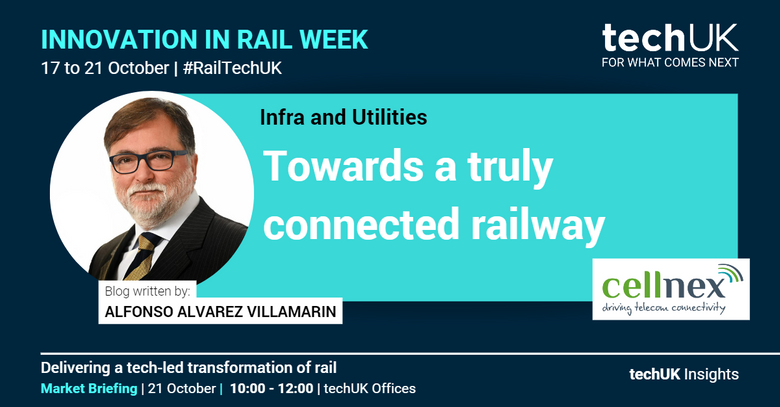Towards a truly connected railway (Guest blog by Cellnex UK)

As the UK faces a declining economy and a widening output gap, innovation by industry is essential to boost growth and productivity. Research by Oxford Economics highlights the rail sector as a key enabler for economic growth, generating £2.20 of income for every £1.00 spent on the rail network*. With rail provision no longer solely focused on transport, but on mobility, placing digital connectivity at the centre of future rail investment creates huge opportunity to drive sustained growth up and down the country.
Investment in digital infrastructure isn’t just about the provision of faster, more frequent routes – there is a distinct and pressing need for high quality, contiguous wireless mobile connectivity across the UK’s rail network, including stations. The deployment of new up to date telecoms infrastructure will not only improve passenger experience, but enable operational and economic transformation via complete digitisation of the UK’s rail network.
Not just a ‘nice-to-have’ – three use cases to transform the UK’s railway
-
Passenger connectivity
Perhaps the most visible opportunity is enhanced passenger experience. As recently as a few years ago, continuous, high-speed connectivity from arrival at the station throughout the journey and to exit at the destination station may have been considered a ‘nice-to-have’ by passengers. In a post-pandemic world, people are seeking the autonomy to work where and when they want, with many employers shunning the traditional nine to five and allowing employees to count their commute as part of the working day. Fast, uninterrupted connectivity will enable genuine productivity during this time – with passengers able to take calls, join meetings and use cloud based software without disruption.
This point becomes particularly relevant when looking at the way the UK uses railways. Compared to the rest of Europe, our passengers travel on a much greater number of ‘medium distance’ commuter journeys. The result is a lower propensity to connect to bespoke onboard solutions (e.g. WiFi) and preference for use of existing trusted mobile services, creating a real need for public mobile networks to ‘reach’ directly into the train and be available at stations. Many countries have responded to this by setting obligations for public mobile network coverage and performance along railways – at present, the UK is yet to follow suit.
Connectivity also plays an important role in attracting leisure travellers, with a fully connected experience acting as a real differentiator against car travel and low-budget airline offerings.
-
Non-mission critical monitoring
The second area of opportunity is connecting and monitoring assets and objects along the rail network. This offers the potential to transform how non-mission critical/non-real time activity - for example maintenance - is undertaken across the railway supply chain.
The deployment of Internet of Things (IoT) capability will dramatically change how assets are monitored, how maintenance is scheduled (e.g. shift of focus to targeted predictive) and how passengers are kept informed (e.g. improved train status information), along with a multitude of other use cases which deliver increased operational efficiency.
The expansion and improvement of public mobile networks referred to in the first use case will further support the transformation of operations, with workers and organisations across the wider rail supply chain having access to high-quality, continuous mobile coverage.
Cellnex UK is already collaborating with Network rail on one such project that will provide uninterrupted cellular internet, mobile reception and fibre services all the way along the busy commuter route between Brighton and London, including through tunnels, ‘not-spots’ and in rural communities. The project will provide a fully connected experience to passengers – up to 300,000 a day at peak – and enable increased capacity for the use of IoT and other smart applications in operations along the line.
-
Future mission critical telecommunications system
The third element is the future mission critical telecommunications system, known as Future Railway Mobile Communication System (FRMCS), which will replace the current ‘2G’ based GSM-R system in underpinning the entire operational system of the UK’s rail network. The new system will increase safety and improve operational efficiency by utilising the latest generation of wireless technology and global 3GPP standards. This enables key applications such automated train control which will enhance network utilisation and punctuality along with further applications such as video support and train control systems, including ETCS.
The deployment of FRCMS this will revolutionise how our railways operate and complete the digitisation of the network.
A single, sustainable, futureproof set of infrastructure
The building blocks for all three requirements are relatively straightforward, fibre (a lot), radio sites (quite a lot), spectrum (some) and radio technology (plenty) with the first two as the bedrock. Crucially, initial design activity needs to consider all three use cases - deployments which only address passenger connectivity will require a completely new and parallel set of infrastructure for operational use cases, creating unnecessary environmental impact and reducing economic efficiency.
It’s also essential that design work considers future technologies, including 6G. Only in doing so will we create an infrastructure that facilitates innovation for growth.
Collaboration is key
The success of such transformation will lie in a collaborative partnership between rail operators, government, telecoms infrastructure providers, and mobile operators. Traditionally, there hasn’t been a huge amount of collaboration between rail and mobile operators in Europe – but there is a clear need now for both the public and private sectors to work together.
A truly connected railway presents real opportunity to put rail at the heart of the UK’s push to drive economic growth and productivity, with clear benefits for passengers and the entire railway ecosystem. To make this a reality in the near future, collaboration is vital, and digital connectivity must remain a key element of the government’s and the railway industry’s vision if we hope to turbocharge the economy and boost productivity.
* Source: https://www.oxfordeconomics.com/resource/the-economic-contribution-of-uk-rail/
Get involved with our work
All of techUK’s work is led by our members – keep in touch or get involved with our work on transport and infrastructure by joining our groups.



